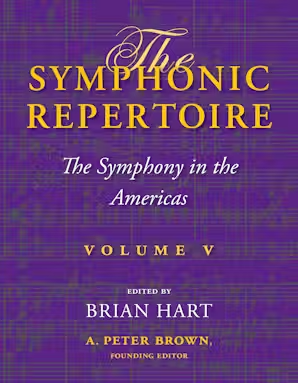 Brian Hart thought the hardest part of editing the fifth volume of “The Symphonic Repertoire” was going to be filling the shoes of Indiana University’s Peter Brown, who had created and written much of this series, which covers the history of the musical genre of the symphony from its beginnings in the 18th century up to the present day.
Brian Hart thought the hardest part of editing the fifth volume of “The Symphonic Repertoire” was going to be filling the shoes of Indiana University’s Peter Brown, who had created and written much of this series, which covers the history of the musical genre of the symphony from its beginnings in the 18th century up to the present day.
Brown had completed the second, third, and fourth volumes before his death in 2003 (he left an outline for the first volume, which chronicles the origins of the symphony in 18th-century Europe, and it was completed and co-edited by two Classical-era scholars). He planned for the fifth volume, covering the symphony in the Americas and the symphony from 1930 on in Europe, to be a symposium of chapters contributed by a series of authors.
Hart, NIU professor of music and coordinator of music history and literature had contributed a chapter to volume three on the symphony in 19th-century France and, as the only scholar other than Brown to have written a chapter in any of those three volumes, Brown’s widow and Indiana University Press thought him the obvious choice to take over as editor for volume five. “I agreed to do it,” Hart said. “Then very quickly we decided one volume is not going to cover all of that. I wanted a volume on the symphony in the Western Hemisphere all by itself.” He did not expect the project to take a decade to write and edit, interrupted midway through by a global pandemic, but he is very proud of the more than 1,000 page finished product.
In 2013, Hart got to work drafting all of the chapters and consulting with various American music specialists about who would be good authors for each. Seven writers were commissioned, and in 2015 Hart reviewed their first drafts. One writer dropped out, which required another to step in and start mostly from scratch. And then just as the project was advancing, the pandemic threw everything into disarray.
Once the writers had finished, the Press undertook the process of sending the chapters to outside readers for their evaluations and input. Then, after the authors made the final revisions, it was time for the copy editors to do their work, and finally, last summer, Hart, as the senior editor, read and edited the proofs of the entire text. Once that was complete, professional indexers in Texas developed the 100-page index.
The result is a systematic chronological study of the symphony of the United States from the early 19th century until today. The final chapter is the first in the series that covers a number of living composers, giving that chapter’s author a unique chance to correspond with some of the subjects. There is also a chapter devoted to the symphony in South America and one on the symphony in Central America and the Caribbean, both written by an expert in Latin American music.

Brian Hart, NIU Professor of Music and Coordinator of Music History and Literature
Hart said that themes that run through the volume include contextual issues at the time, the growth of orchestras, the conception of repertoire and what he feels is the biggest issue the American symphony has faced, the concept of creating or identifying “the great American symphony.”
“Huckleberry Finn was generally regarded as reaching the status of the great American novel,” Hart said. “But music critics and conductors were always trying to apply that standard to find the great American symphony. The music critics more than anyone tried to establish a criteria for what would make the great American symphony. It would have to have universal appeal like Beethoven, but it also would have to have an individual American character. They looked somewhat paradoxically at Walt Whitman rather than a novelist as the ideal person, somebody who continues in the tradition of poetry, but is innovative and openly celebrates the nation. So, the American composer had to fit both criteria, and the criteria kept changing with each generation. Every time you had a symphony that might be the one, critics might say, ‘it’s a great symphony, but it’s not the great American symphony.’ And, if you asked them why, they might not able to answer it. A lot of it had to do with the fact that American music had a real inferiority complex to deal with for many, many years.”
Hart said that inferiority complex was based on the widely held idea that American music didn’t measure up to European music.
“Throughout most of the 19th century and well into the 20th century, there was this sense that, we’re the land of technical and scientific innovation, not cultural innovation,” Hart said. ” The Europeans didn’t help. One famous American pianist applied to study at the Paris Conservatory, and the teacher dismissed him with, ‘America is a land of steam engines.’ That was the 1840s, but that persisted, and had no little part in driving this very quixotic search for the great American symphony. Leonard Bernstein really popularized the phrase because he wrote an article called Whatever Happened To That Great American Symphony? By the 1950s, Bernstein was afraid that it was getting impossible to write any symphony, let alone a great American one, because after World War II, there were lots of changes towards non-tonal systems of writing music.”
According to Hart, the quest to create the great American symphony has largely been abandoned, which has proved to be liberating for the art form. Despite the widespread lack of programming of American compositions that has continued into the 21st century, many people in today’s generations still embrace the symphony. “Philip Glass said there was no financial incentive to write symphonies,” Hart said. “And yet, he’s written 14 of them.”
Hart said that Mohammed Fairouz, a young Arab American composer who has written five symphonies, has stated that “I don’t think the poetry of this form has even begun to be examined.”
“The symphony takes lots of different forms today, it doesn’t just follow the traditional four-movement form,” Hart said. “I think people are finding it very liberating. It’s a way of making, as one composer called it, the grand statement with the orchestra, with the wide and varied colors and things like that. It was a good opportunity for the authors to explore all the different things that might’ve had an influence on the development of the symphony.”
As the process of creating the book began, Hart was advised to tell the chapter authors that he would be a “very interventionist editor.” The completed book needed to be of a piece with the previous volumes and he needed to ensure that the chapters conformed to the series.
“While we’re making chronological divisions, like symphony from 1920 to 1950, or 1950 to 1970, some of these composers overlap,” he said. “I would place the composer with the period where I thought that they had the biggest influence. Sometimes they had the biggest influence in one period and their own most famous symphonies in another period. It’s the tradition of this series to cover all of the authors works in one sitting. I would put them wherever I thought best, but we would do some cross-fertilization. Some of the authors talked with each other on their own, to build that. That was really good.”
Hart said he is amazed at the amount of work that went into the project. He estimates that without the pandemic it would have been completed in 2021. And that timeline has him thinking that he might be up to tackling volume six, with a couple of provisos.
He’d like to take a little bit of a break, and he wouldn’t object to having a co-editor.
“The next volume would cover a lot more regions, which means more authors, which is a lot more cats to herd,” he said. “My gift is the proofreading and drawing in some of the connections. I think if the co-editor did the bulk of the administrative work, it would go well. I sure enjoyed the reading.”
And now we can, too.
“The Symphonic Repertoire, Volume V: The Symphony in the Americas” edited by Brian Hart is available through Indiana University Press and can be purchased at Amazon, Barnes and Noble, Bookshop, Books-A-Million and other book retailers.


